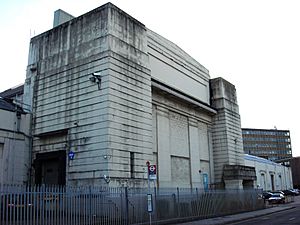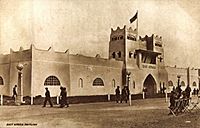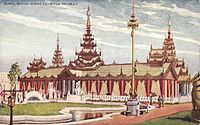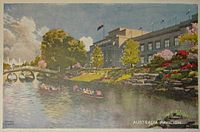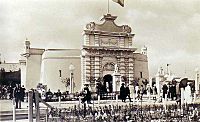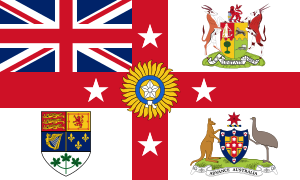British Empire Exhibition facts for kids
The British Empire Exhibition was a huge event held in Wembley Park, London, England. It ran from April to November in 1924 and again from May to October in 1925. It was like a giant fair where countries from across the British Empire came together to show off their cultures, products, and achievements.
Contents
- Why the Exhibition Happened
- The Empire Stadium
- Getting There: Exhibition Station
- Building the Exhibition
- Grand Opening
- What You Could See
- Railway Exhibits
- Pears' Palace of Beauty
- Other Fun Things to Do
- Exciting Events
- London Defended Air Show
- Stamps and Medals
- What Happened After
- Wembley's Growth
- See also
Why the Exhibition Happened
In 1920, the British Government decided to host this big exhibition. They chose Wembley Park as the location. The idea for such an event had been discussed before, but World War I stopped earlier plans.
After World War I, Britain faced some challenges. Even though they won the war, other powerful countries like America and Japan were becoming very strong. Britain also had money problems. Leaders hoped the Exhibition would help strengthen the bonds within the Empire. They wanted to boost trade and show the world how great Britain and its Empire still were. It was also a way to get people in Britain more interested in the Empire.
The Prince of Wales, who later became Edward VIII, was the head of the organizing committee. He also wanted the Exhibition to have "a great national sports ground." This led to the building of Wembley Stadium in 1923, which became very famous.
The Empire Stadium
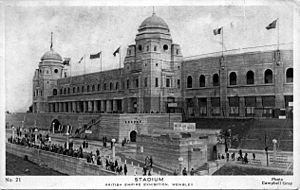
A special "great national sports ground" was built for the Exhibition. It was called the Empire Stadium, and it later became the famous Wembley Stadium.
Construction of the stadium began in January 1922 and was finished in just 10 months. It was ready even before the rest of the Exhibition opened! The stadium could hold 125,000 people, with 30,000 seated. It had a unique design, mixing old Roman and Indian styles.
While it had a football pitch, it was not just for football. It also had a long running track, which was very important.
Getting There: Exhibition Station
Wembley Park station was rebuilt for the British Empire Exhibition. A new train station, called Exhibition Station (Wembley), was also built. It connected the Exhibition directly to Marylebone in London. This new station opened on April 28, 1923, the same day as Wembley Stadium's first big event, the 1923 FA Cup Final. It was mainly used to bring visitors to Wembley events.
Building the Exhibition
The Exhibition needed many buildings in different styles, which was an exciting challenge for the architects. To build everything quickly, they used a new material called "reinforced concrete." This made Wembley Park known as the world's first "concrete city."
Almost 2,000 workers helped build the Exhibition buildings between 1923 and 1924.
The buildings showed off different cultures:
- The Indian pavilion had towers and domes.
- The West African pavilion looked like an Arab fort.
- The Burmese pavilion was designed like a temple.
- The South African building showed a Dutch style.
Besides the Stadium and the pavilions for each country, there were four other main buildings: the Palaces of Engineering, Industry, and Arts, and the HM Government Building. These large palaces were built in a Roman style, showing the power of the Empire. The Palaces of Industry and Engineering were the biggest reinforced concrete buildings in the world at that time.
The famous writer Rudyard Kipling even helped name the roads inside the Exhibition! The site also had what might have been the world's first bus station, which could handle 100,000 passengers a day.
Grand Opening
King George V officially opened the British Empire Exhibition on April 23, 1924, which is Saint George's Day. This opening ceremony was special because it was the first time a British monarch's speech was broadcast on BBC Radio. The King also sent a telegram that traveled around the world in just one minute and 20 seconds!
What You Could See
Almost all of the 58 territories in the British Empire participated in the Exhibition, with 56 of them having their own displays and pavilions. The main goal was to "stimulate trade, strengthen bonds... and enable all who owe allegiance to the British flag to meet on common ground."
The Exhibition cost £12 million and was the largest exhibition ever held anywhere in the world at that time. It attracted an amazing 27 million visitors!
The Palace of Engineering was the largest building. It showed off engineering, shipbuilding, electric power, cars, and trains. The Palace of Industry, slightly smaller, featured displays on chemicals, coal, food, and clothing.
Each country had its own unique pavilion:
- The Canada Pavilion showed minerals, farming, and even a life-sized statue of the Prince of Wales made of butter!
- The Australian Pavilion had a huge 16-foot ball of Australian wool.
- The Malta pavilion looked like a fortress with its entrance designed like the Mdina Gate.
The Palace of Arts displayed historical room sets, paintings, and sculptures. It also featured the famous Queen Mary's Dolls' House, which is now at Windsor Castle. This tiny house even had miniature bottles of Bass beer!
Many small shops, called kiosks, were set up by companies from across the Empire. They sold souvenirs and promoted business.
Railway Exhibits
Several railway companies showed off their latest trains and coaches at the Exhibition. One very famous train on display was the LNER 4472 Flying Scotsman. Another famous train, GWR 4079 Pendennis Castle, joined it in 1925. Visitors could see these powerful locomotives up close.
Pears' Palace of Beauty
Among the many commercial kiosks, the Pears' Palace of Beauty was one of the largest. It sold souvenir soaps and was located in the funfair area. This white building had two curved staircases leading to a domed area.
Inside, it was an exhibition space with 10 special rooms. Each room had an actress dressed as a famous beautiful woman from history, like Helen of Troy or Cleopatra. They were surrounded by furniture from their time. Almost 750,000 people visited the Palace of Beauty!
Other Fun Things to Do
Besides the pavilions, there was a lake, a funfair, a garden, and even a working replica coal mine! There were also many restaurants, including one that served Indian food.
Most attractions were free after you paid to get in. You could even explore the Exhibition after dark. To get around, visitors could ride on two special "light railways" or electric "Railodok" buses, which were like open-sided luggage trolleys.
Exciting Events
The Empire Stadium hosted many exciting events:
- Concerts by massed bands and choirs.
- Military and historical displays.
- A "Pageant of Empire" with thousands of actors, showing the history of the Empire. The famous composer Edward Elgar wrote music for this pageant.
- The first Rugby Union match played at Wembley.
- A simulated air attack on London called "London Defended."
- A real rodeo with cowboys and horses.
In August 1924, a large Imperial Jamboree for Boy Scouts was held at Wembley. About 13,000 Scouts from all over the Empire attended, making it the biggest Scout camp at that time.
London Defended Air Show
From May to June 1925, No. 32 Squadron RAF put on an air show called "London Defended." Airplanes flew at night over the Exhibition. They were painted red and had white lights on their wings. The show included firing blank ammunition and dropping fireworks to make it look like bombs were falling. It was a very dramatic display!
Stamps and Medals
The Exhibition was important for stamp collectors because it was the first time the British Post Office issued special commemorative postage stamps. Two stamps were released in 1924, and the same designs were reissued in 1925 with the new year. Many special medals were also made for the Exhibition.
What Happened After
Even though the Exhibition was very popular and had 27 million visitors over two years, it didn't make a profit. It cost over £6 million. Some people even called it the world's biggest outdoor failure.
Two of the most popular attractions were American dodgem cars and a copy of the tomb of Tutankhamen. The tomb was in the funfair because Egypt had become independent from Britain in 1922.
Most of the Exhibition buildings were meant to be temporary and taken down. However, because they were so big and made of concrete, some parts, like the Palace of Industry, lasted until the 2010s. The Empire Stadium was saved and became the famous Wembley Stadium, the home of Football in England until it was replaced by a new stadium in 2003.
Wembley's Growth
The British Empire Exhibition greatly influenced the development of Wembley. New roads were built, and bus services were added. Many visitors who saw Wembley during the Exhibition later decided to move there when new houses were built. The Stadium's survival also ensured that Wembley Park remained a major London attraction.
See also
- Colonial Exhibitions
- Colonialism



